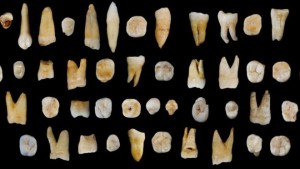The discovery of 47 human teeth from a cave in southern China has rewritten the narrative of our ancestors’ spread out of Africa. Scientists excavating an area in Daoxian say the fossils belong to modern humans and date to at least 80,000 years ago. The date is 20,000 years earlier than had been previously thought, and fills a gap our knowledge on the spread of modern humans around the world. It suggests that modern humans reached southern China from Africa long before they had arrived in northern China or Europe.
“All the fossils have been sealed in a calcitic floor, which is like a gravestone, sealing them off. So the teeth have to be older than that layer. Above that are stalagmites that have been dated using uranium series to 80,000 years. This means that everything below those stalagmites must be older than 80,000 years old, the human teeth could be as old as 125,000 years, according to the researchers. In addition, the animal fossils found with the human teeth are typical of the Late Pleistocene, the same period indicated by the radioactive dating evidence.
Some fossils of modern humans that predate the Out of Africa migration are already known, from the Skhul and Qafzeh caves in Israel. But these have been regarded as part of a failed early dispersal of modern humans who probably went extinct. However, the discovery of unequivocally modern fossils in China clouds the picture. “Some researchers have proposed earlier dispersals in the past,” said Dr Martinón-Torres. “We really have to understand the fate of this migration. We need to find out whether it failed and they went extinct or they really did contribute to later people. “Maybe we really are descendents of the dispersal 60,000 years ago but we need to re-think our models. Maybe there was more than one Out of Africa migration.”
Prof Chris Stringer, from London’s Natural History Museum said the new study was “a game-changer” in the debate about the spread of modern humans.The large sample of teeth from Daoxian seem unquestionably modern in their size and morphology, and they look to be well-dated by uranium-thorium methods to at least 80,000 years. At first sight this seems to be consistent with an early dispersal across southern Asia by a population resembling those known from Skhul and Qafzeh. “But the Daoxian fossils resemble recent human teeth much more than they look like those from Skhul and Qafzeh, which retain more primitive traits. So either there must have been rapid evolution of the dentitions of a Skhul-Qafzeh type population in Asia by about 80,000 years, or the Daoxian teeth represent a hitherto-unsuspected early and separate dispersal of more modern-looking humans.”
Dr Pontus Skoglund, from the department of genetics at Harvard Medical School, told BBC News: “The genetic evidence we have puts strong constraints on some aspects of human history, but less so on the timing of the out of Africa event. Most genetic reconstructions based on modern data relies on assumptions on the mutation rate, for which there are still some real uncertainties. “In terms of direct genetic evidence, we already have a 45,000 year-old genome from Siberia (Ust Ishim) and a 40,000 year old individual from Europe (Oase) that are consistent with being from now-mostly-extinct lineages.”
“The conclusion is perhaps that the genetics does allow an 80,000 year old East Asian population to contribute some ancestry to present-day people. It is a very interesting discovery that is hard to fit in our current thinking, but not impossible. We are just starting to cope with this data point.”Dr Martinón-Torres said the study could also shed light on why it took Homo sapiens another 40,000 years to settle Europe. Perhaps the presence of the Neanderthals kept our species out of westernmost Eurasia until our evolutionary cousins started to dwindle in number. However, it’s also possible that modern humans who started out as a tropical species were not as well-conditioned as the Neanderthals for the icy climate in Europe. She noted that while modern humans occupied the warmer south of China 80,000 years ago, the colder regions of central and northern China appear to be settled by more primitive human groups who may have been Asian relatives of the Neanderthals.
For more information please visit: http://nature.com


Comments are closed.